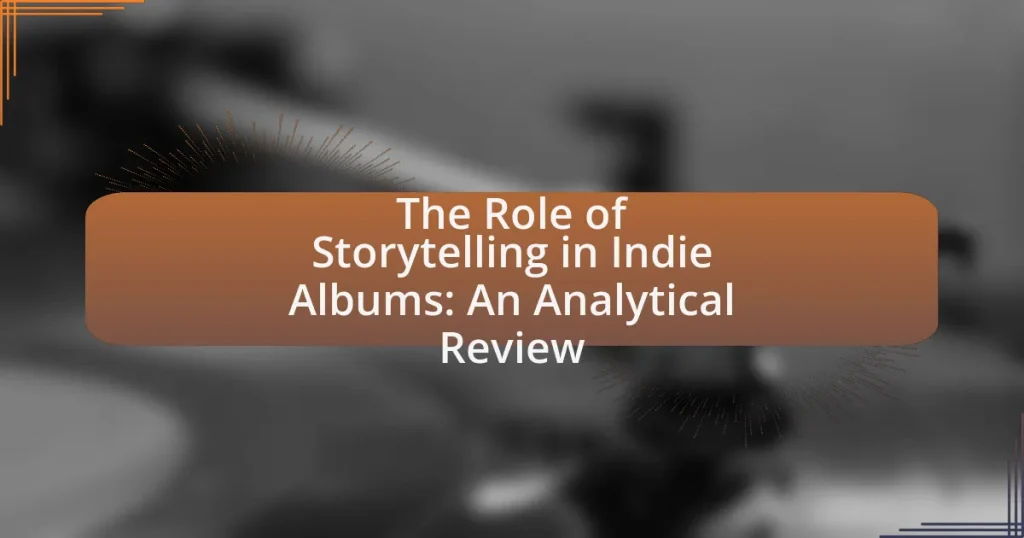The article focuses on the production techniques used in indie albums, highlighting key methods such as home recording, minimalism, and sound experimentation. It examines how recording methods differ in indie music production, emphasizing a DIY approach and the use of digital audio workstations. The article also discusses the impact of recording environments on sound quality, the importance of mixing and mastering, and how budget constraints influence production choices. Additionally, it outlines best practices for recording in an indie context and provides resources for aspiring indie producers to enhance their skills.

What are the key production techniques used in indie albums?
The key production techniques used in indie albums include home recording, minimalism, and experimentation with sound. Home recording allows artists to produce music in a more cost-effective manner, often using affordable equipment and software, which has been a hallmark of the indie music scene since the rise of digital technology in the late 1990s. Minimalism focuses on stripping down arrangements to their essential elements, creating a raw and authentic sound that resonates with listeners. Additionally, experimentation with sound, such as incorporating unconventional instruments or recording techniques, enables indie artists to develop a unique sonic identity, as seen in the works of bands like Bon Iver and Sufjan Stevens. These techniques collectively contribute to the distinctiveness and artistic freedom characteristic of indie albums.
How do recording methods differ in indie music production?
Recording methods in indie music production often differ from mainstream practices by emphasizing a DIY approach, utilizing home studios, and prioritizing artistic expression over commercial viability. Indie artists frequently employ less expensive equipment and software, allowing for greater experimentation and a more personal sound. For instance, many indie musicians record tracks using digital audio workstations (DAWs) like Ableton Live or GarageBand, which provide flexibility and accessibility. This contrasts with major label productions that typically rely on high-budget studios and professional engineers. Additionally, indie productions often incorporate unconventional recording techniques, such as live takes and ambient sounds, to create a unique auditory experience, reflecting the artist’s individual style and vision.
What are the most common recording techniques employed by indie artists?
Indie artists commonly employ techniques such as home recording, multi-tracking, and the use of digital audio workstations (DAWs). Home recording allows artists to create music in a familiar environment, often using affordable equipment, which has become increasingly accessible due to advancements in technology. Multi-tracking enables artists to layer different sounds and instruments, providing depth and complexity to their recordings. The use of DAWs, such as Ableton Live or GarageBand, facilitates editing and mixing, allowing for greater creative control and experimentation. These techniques reflect the DIY ethos prevalent in the indie music scene, where artists prioritize artistic expression and personal vision over traditional studio constraints.
How does the choice of recording environment impact the sound of indie albums?
The choice of recording environment significantly impacts the sound of indie albums by influencing acoustics, ambiance, and the overall sonic character. Different environments, such as home studios, professional studios, or live venues, create unique sound profiles due to variations in room size, shape, and materials, which affect sound reflection and absorption. For instance, a home studio may produce a more intimate and raw sound, while a professional studio often offers superior equipment and acoustically treated spaces that enhance clarity and depth. Research indicates that the recording environment can alter frequency response and spatial characteristics, leading to distinct auditory experiences in the final product.
What role does mixing play in the production of indie albums?
Mixing plays a crucial role in the production of indie albums by balancing and enhancing individual audio tracks to create a cohesive final product. This process involves adjusting levels, panning, equalization, and effects to ensure that each element of the music is clear and contributes to the overall sound. For instance, a well-mixed indie album can elevate the emotional impact of the music, making it more engaging for listeners. According to a study by the Audio Engineering Society, effective mixing techniques can significantly improve listener perception and enjoyment, highlighting the importance of this stage in the production process.
How do indie producers approach the mixing process differently than mainstream producers?
Indie producers approach the mixing process with a focus on artistic expression and experimentation, contrasting with mainstream producers who often prioritize commercial viability and polished sound. Indie producers frequently utilize unconventional techniques, such as lo-fi recording methods and unique sound layering, to create a distinct sonic identity. This approach allows for greater creative freedom, as indie producers may prioritize the emotional impact of the music over technical perfection. For instance, a study by the University of Southern California found that indie music often embraces rawness and authenticity, which resonates with audiences seeking genuine artistic expression. In contrast, mainstream producers typically adhere to industry standards and trends, resulting in a more formulaic mixing process aimed at maximizing radio play and sales.
What are the essential mixing techniques that enhance indie music?
The essential mixing techniques that enhance indie music include careful balancing of levels, creative use of reverb and delay, and effective panning. Balancing levels ensures that each instrument and vocal is clearly heard, which is crucial in the often layered arrangements typical of indie music. Creative use of reverb and delay adds depth and atmosphere, allowing tracks to feel more immersive and engaging. Effective panning helps to create a sense of space in the mix, making it feel more dynamic and alive. These techniques are supported by the fact that many successful indie albums, such as Bon Iver’s “For Emma, Forever Ago,” utilize these methods to create a distinct sound that resonates with listeners.
Why is mastering important for indie albums?
Mastering is crucial for indie albums because it ensures a polished and professional sound that enhances the overall listening experience. This final step in the audio production process balances the sonic elements, optimizes volume levels, and prepares the music for distribution across various platforms. Mastering also addresses issues such as frequency imbalances and dynamic range, which can significantly affect how the album is perceived by listeners. According to a study by the Audio Engineering Society, properly mastered tracks can increase listener engagement and satisfaction, making it essential for indie artists to invest in this process to compete in a crowded market.
What are the key differences in mastering indie albums compared to major label releases?
The key differences in mastering indie albums compared to major label releases include budget constraints, creative control, and production resources. Indie albums often operate with limited budgets, which can lead to less sophisticated mastering techniques and equipment, while major label releases typically have access to high-end studios and experienced mastering engineers. Additionally, indie artists usually retain more creative control over their sound, allowing for unique mastering choices that reflect their artistic vision, whereas major labels may impose commercial standards that prioritize marketability. This difference in approach can result in a more polished and commercially viable sound for major label releases, while indie albums may exhibit a rawer, more experimental quality.
How can indie artists ensure their albums are effectively mastered?
Indie artists can ensure their albums are effectively mastered by hiring a professional mastering engineer who specializes in their genre. Professional mastering engineers possess the technical expertise and experience necessary to enhance the overall sound quality, ensuring that the album translates well across various playback systems. According to a study by the Audio Engineering Society, professional mastering can improve perceived loudness and clarity, which are critical for listener engagement. Additionally, indie artists should provide the mastering engineer with reference tracks that exemplify the desired sound, facilitating a clearer understanding of the artistic vision.

What influences the production choices in indie albums?
Production choices in indie albums are primarily influenced by artistic vision, budget constraints, and the desire for creative freedom. Artists often prioritize their unique sound and personal expression, leading to decisions that reflect their individual styles rather than mainstream trends. Budget limitations frequently dictate the choice of recording equipment, studio time, and production personnel, compelling artists to adopt innovative techniques or DIY approaches. Additionally, the indie music scene values authenticity, prompting artists to experiment with unconventional sounds and recording methods, which can result in distinctive sonic qualities. This combination of factors shapes the overall production landscape of indie albums, allowing for a diverse range of musical expressions.
How do budget constraints affect production techniques in indie music?
Budget constraints significantly influence production techniques in indie music by limiting access to high-end equipment and professional studios. Indie musicians often resort to home recording setups, utilizing affordable software and hardware to produce their music. This shift encourages creativity and innovation, as artists experiment with unconventional methods and sounds to achieve their desired results. For instance, many indie artists use digital audio workstations (DAWs) like Ableton Live or GarageBand, which are cost-effective alternatives to traditional studio recording. Additionally, the use of DIY techniques, such as recording in non-traditional spaces, has become common, allowing artists to create unique acoustic environments that enhance their sound. This adaptability not only reflects the resourcefulness of indie musicians but also contributes to the distinctiveness of the indie music genre.
What are some cost-effective production strategies for indie artists?
Indie artists can implement several cost-effective production strategies, including utilizing home studios, collaborating with local musicians, and leveraging digital distribution platforms. Home studios allow artists to record high-quality music without the high costs associated with professional studios, as evidenced by the rise of affordable recording equipment and software. Collaborating with local musicians can reduce costs by sharing resources and skills, fostering a community approach to music production. Additionally, digital distribution platforms like Bandcamp and DistroKid enable indie artists to release their music directly to audiences without the need for traditional record labels, significantly lowering distribution costs. These strategies collectively empower indie artists to produce and share their music efficiently and economically.
How can limited resources lead to innovative production techniques?
Limited resources can drive innovative production techniques by forcing creators to think creatively and utilize available tools in unconventional ways. For instance, indie musicians often work with minimal budgets, leading them to explore DIY recording methods, such as using home studios or mobile recording devices. This necessity has historically resulted in unique soundscapes, as seen in the lo-fi aesthetic popularized by artists like Beck and Neutral Milk Hotel, who embraced the limitations of their equipment to create distinctive audio experiences. Such constraints encourage experimentation with sound manipulation and layering, ultimately fostering originality in music production.
What impact do artistic vision and genre have on production techniques?
Artistic vision and genre significantly influence production techniques by dictating the choices made in sound design, instrumentation, and recording methods. For instance, an artist with a clear vision may opt for lo-fi recording techniques to evoke a raw, authentic sound typical of indie music, while a genre like electronic may require high-fidelity production to achieve polished, synthesized sounds. Historical examples include the use of analog equipment in the production of albums like “In the Aeroplane Over the Sea” by Neutral Milk Hotel, which aligns with the indie genre’s aesthetic of nostalgia and imperfection. Conversely, genres such as pop often utilize advanced digital production techniques to create a clean, commercial sound, demonstrating how artistic intent shapes the technical approach to music production.
How do different genres within indie music influence production choices?
Different genres within indie music significantly influence production choices by dictating the instrumentation, recording techniques, and overall sound aesthetics. For instance, indie rock often emphasizes live instrumentation and raw sound, leading to a preference for analog recording methods to capture authenticity, as seen in albums like “Funeral” by Arcade Fire. In contrast, indie pop may utilize electronic elements and polished production techniques, favoring digital recording to achieve a more refined sound, exemplified by artists like CHVRCHES. Additionally, genres like indie folk prioritize acoustic instruments and organic sounds, which influences producers to focus on capturing the natural ambiance of recordings, as demonstrated in Sufjan Stevens’ “Carrie & Lowell.” Thus, the specific characteristics of each genre shape the choices producers make in the recording process, ultimately affecting the final output of the music.
What are some examples of unique production techniques that reflect an artist’s vision?
Unique production techniques that reflect an artist’s vision include the use of unconventional recording environments, such as capturing sounds in natural settings or unique architectural spaces, which can enhance the emotional depth of the music. For instance, Bon Iver recorded parts of his album “For Emma, Forever Ago” in a remote Wisconsin cabin, utilizing the acoustic properties of the space to create an intimate sound. Additionally, artists like Sufjan Stevens employ layering of diverse instrumentation and field recordings, as seen in “Illinois,” to create a rich tapestry that conveys personal narratives and cultural references. These techniques not only showcase the artist’s creativity but also serve to deepen the listener’s connection to the music.

How can indie artists improve their production techniques?
Indie artists can improve their production techniques by investing in quality recording equipment and software, as well as enhancing their skills through online courses and tutorials. High-quality microphones and audio interfaces can significantly elevate sound clarity, while digital audio workstations (DAWs) like Ableton Live or Logic Pro provide advanced editing capabilities. According to a 2021 survey by the Music Producers Guild, 70% of successful indie artists attribute their sound quality improvements to better equipment and software. Additionally, engaging with online communities and seeking feedback can help artists refine their techniques and gain new insights into production practices.
What are some best practices for recording in an indie context?
Best practices for recording in an indie context include prioritizing pre-production planning, utilizing affordable yet high-quality equipment, and fostering a collaborative environment. Pre-production planning ensures that all elements, such as song arrangements and instrumentation, are well thought out, which can lead to a more efficient recording process. Using affordable equipment, like USB microphones and digital audio workstations, allows indie artists to achieve professional sound without significant financial investment. Collaboration among band members and with producers or sound engineers can enhance creativity and result in a more polished final product. These practices are supported by the fact that many successful indie albums have emerged from home studios, demonstrating that quality recordings can be achieved outside of traditional studio settings.
How can artists optimize their home studio setups for better sound quality?
Artists can optimize their home studio setups for better sound quality by implementing acoustic treatment, using high-quality microphones, and ensuring proper monitoring. Acoustic treatment, such as bass traps and sound panels, reduces unwanted reflections and reverberations, leading to a clearer sound. High-quality microphones capture sound more accurately, which is essential for achieving professional results. Proper monitoring involves using studio monitors that provide a flat frequency response, allowing artists to hear their mixes accurately. According to a study by the Audio Engineering Society, untreated rooms can introduce significant coloration to sound, emphasizing the importance of acoustic treatment for achieving optimal sound quality.
What tips can help indie musicians achieve professional-sounding mixes?
Indie musicians can achieve professional-sounding mixes by focusing on proper gain staging, utilizing high-quality plugins, and incorporating reference tracks. Proper gain staging ensures that audio levels are optimized throughout the mixing process, preventing distortion and maintaining clarity. High-quality plugins, such as those from reputable brands, provide better sound processing capabilities, enhancing the overall mix quality. Additionally, using reference tracks allows musicians to compare their mixes to professionally produced songs, helping them identify areas for improvement in balance, EQ, and dynamics. These techniques are widely recognized in audio production and have been validated by industry professionals, emphasizing their effectiveness in achieving polished mixes.
What resources are available for learning about indie music production?
Online courses such as those offered by Coursera, Udemy, and Skillshare provide structured learning on indie music production. These platforms feature courses taught by industry professionals, covering topics from basic recording techniques to advanced mixing and mastering. Additionally, YouTube channels like Produce Like A Pro and Recording Revolution offer free tutorials and insights into the indie music production process. Books such as “The Art of Music Production” by Richard James Burgess and “Mixing Secrets for the Small Studio” by Mike Senior serve as valuable resources for understanding production techniques specific to indie music. Furthermore, forums like Gearslutz and Reddit’s r/WeAreTheMusicMakers provide community support and discussions that can enhance learning through shared experiences and advice.
Which online courses or tutorials are recommended for aspiring indie producers?
Aspiring indie producers are recommended to take online courses such as “Music Production in Logic Pro X” on Udemy, “The Complete Ableton Live 11 Music Production” on Skillshare, and “Introduction to Music Production” by Berklee Online. These courses provide comprehensive training in music production software and techniques essential for indie music creation. For instance, the Berklee course is well-regarded for its structured curriculum and industry-relevant insights, making it a valuable resource for beginners.
How can networking with other indie artists enhance production skills?
Networking with other indie artists enhances production skills by facilitating knowledge exchange and collaboration on projects. When indie artists connect, they share techniques, tools, and experiences that can lead to improved production quality. For instance, a study by the Berklee College of Music found that collaboration among musicians often results in innovative sound design and production methods, as artists learn from each other’s strengths and weaknesses. This collaborative environment fosters creativity and encourages experimentation, ultimately refining an artist’s production capabilities.



